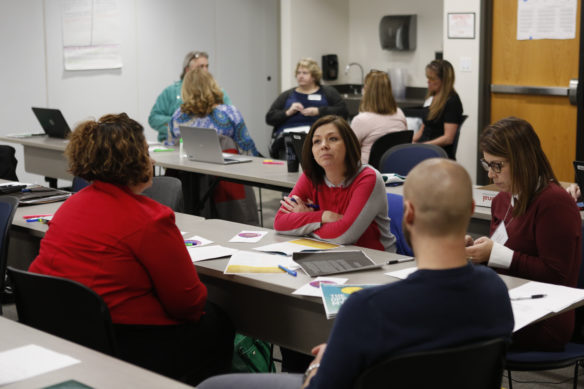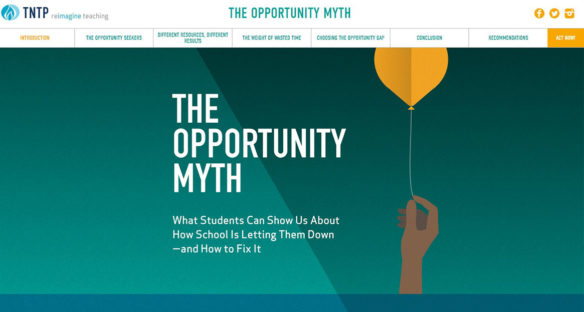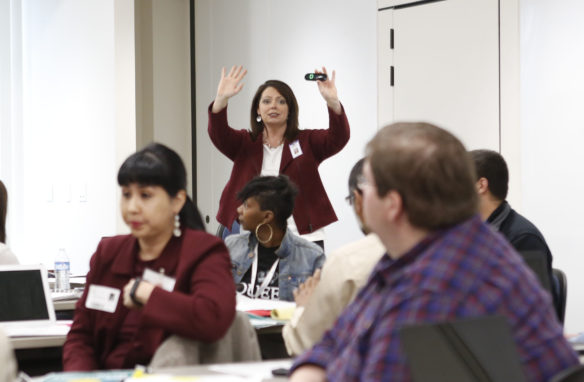
Shawnda Fizer, center, a 5th-grade teacher at Ewing Elementary School (Fleming County), discusses “The Opportunity Myth” study with colleagues at a meeting of the Commissioner’s Teacher Advisory Council in Frankfort. The study released last year concludes that while students tended to succeed equally on grade-level work, many students of color are not being given grade-level assignments.
Photo by Mike Marsee, Jan. 18, 2019
- “The Opportunity Myth” concluded that while students tended to succeed equally on grade-level work, many students of color are not even given grade-level assignments.
- KDE will use the study’s findings to guide its work toward closing the achievement gap in areas from standards revision and implementation to professional learning.
By Mike Marsee
mike.marsee@education.ky.gov
If you haven’t heard about “The Opportunity Myth,” you probably will soon.
The study is the result of an extensive effort by a nonprofit advocacy group to look into what students are doing in class rather than what they are doing in assessments, and its findings will help drive efforts to address the achievement gap in Kentucky schools.
“The Opportunity Myth: What Students Can Show Us About How School Is Letting Them Down – and How to Fix It” concludes that many students – particularly low-income students and students of color – are not being challenged by assignments that are appropriate to their grade level.
Officials at the Kentucky Department of Education (KDE) said that conclusion will guide the agency’s work toward closing the gap in areas from standards revision and implementation to professional learning.
“One of the things that the study found nationally, and that we believe to be the case in Kentucky as well, is disproportionately lower-income students and students of color tend to have less access to grade-level content and curriculum,” Kentucky Education Commissioner Wayne Lewis said. “A big part of our work has to be building the capacity of our teachers to ensure that every kid in the state has access to high-quality, rigorous instruction at grade level, because there’s no way we can expect kids to perform at grade level on assessments if they haven’t had access to that curriculum and rigorous instruction in the content at the grade level.
“We’re talking about the core business of teaching and learning: rigorous instruction, curriculum, content at grade level. We’ve got to make sure we’re there.”
“The Opportunity Myth” study indicates there is much work to be done in that area. The study conducted by TNTP, a nonprofit research and teacher training organization formerly known as the New Teacher Project, concluded that all students tended to succeed on grade-level work, but many students of color never had the opportunity to try. It found that:
- Success rates on grade-level work were similar, with a 56 percent success rate on all grade-level assignments from classrooms with mostly students of color and a 65 percent success rate on all grade-level assignments from classrooms with mostly white students.
- Almost 4 out of 10 classrooms with a majority of students of color never received a single-grade level assignment – 38 percent compared to 12 percent in classrooms with mostly white students.

“The Opportunity Myth,” a study conducted by nonprofit research and teacher training organization TNTP, concludes that many students – particularly low-income students and students of color – are not being challenged by assignments that are appropriate to their grade level. Researchers partnered with five school districts – urban and rural – and observed about 1,000 lessons and reviewed almost 5,000 assignments, more than 20,000 student work samples and almost 30,000 student surveys.
Amanda Ellis, KDE deputy commissioner and chief academic officer, said those findings and the entire study are significant because the research was centered on day-to-day instruction rather than test results. Researchers partnered with five school districts – urban and rural – and observed about 1,000 lessons and reviewed almost 5,000 assignments, more than 20,000 student work samples and almost 30,000 student surveys.
“When we talk about equity, that means equitable access to high-quality instruction and materials and a highly effective teacher who believes students can achieve,” Ellis said. “What we liked about the report is that it gives some really clear and sobering data about grade-level-appropriate instruction that’s going on in schools, grade-level-appropriate resources, student engagement and teacher beliefs.
“They also give very specific recommendations and research around what we can change today in our classrooms, not waiting for a test at the end. That’s something that we can control in our classrooms, that we can control in our schools. It’s something that we can have impact on immediately.”
In fact, that work is already under way. KDE held a meeting last month to present the report to its educational recovery staff, other staff members who work in the field and directors of the state’s educational cooperatives. The report also has been discussed at recent meetings of the Commissioner’s Principal Advisory Council and the Commissioner’s Teacher Advisory Council.
“The folks on these councils are statewide representatives,” said Stacy Noah, a Principal Partnership Project (P3) coach in KDE’s Division of Educator Licensure and Quality. “We consider them the first step in sharing the work, and they will be liaisons in their schools and districts to share it with other teachers.”

Stacy Noah, a Principal Partnership Project (P3) coach in the Kentucky Department of Education’s Division of Educator Licensure and Quality, talks about “The Opportunity Myth” study at a meeting of the Commissioner’s Teacher Advisory Council in Frankfort. KDE plans to use the study’s findings to guide its work toward closing the achievement gap in areas from standards revision and implementation to professional learning.
Photo by Mike Marsee, Jan. 18, 2019
Shawnda Fizer, a 5th-grade teacher at Ewing Elementary (Fleming County) who serves on the Commissioner’s Teacher Advisory Council, said the study should serve as a reminder that students who are lower on the socioeconomic ladder deserve the same opportunity to learn and chance to succeed as their classmates.
“We think we’re doing what’s best for them, but those high expectations are not necessarily in place for those kids, which is a shame because all kids can learn at the same level if you have those high expectations for them,” Fizer said.
The report highlights four key resources that TNTP says every student should have access to:
- Grade-appropriate assignments
- Strong instruction
- Deep engagement
- Teachers with high expectations
Ellis said KDE can help ensure those resources are in place in part through its ongoing rollout of revised academic standards. Senate Bill 1 (2017) calls for the review of standards in all content areas every six years on a rotating basis.
“The study is really guiding our work on how we’re approaching the new standards rollout,” she said. “It’s not just reading a standards document, but it’s what we do to implement those standards. So it gives us an opportunity for a real approach for continuous improvement for schools and districts and then giving them the resources that they can use. It really is a different approach than what we’ve typically taken, but it’s resonating any time we introduce it to educators.”
There also will be an impact in professional learning that emphasizes opportunity and access as well as understanding of the standards, Noah said.
“Opportunity and access is a huge issue, but it’s even more important that teachers are really being engaged in professional learning that allows them to truly understand the intent of the standards so that they in turn can relate it to their students,” Noah said.
The four key resources will be at the heart of a professional learning program for principals and assistant principals from across Kentucky on Feb. 13 in Washington County. Ray said P3’s Spring Semester Learning Lab will teach principals and assistant principals how to support effective instruction by observing full lessons in classrooms throughout the Washington County schools and meeting with the teachers they observe to discuss lesson expectations and outcomes and share reflections.
Ellis said TNTP also offers free online resources to help schools and districts engage in reflection and realignment and focus on improved instruction.
MORE INFO …
“The Opportunity Myth” summary and link to full report




[…] this story from Kentucky Teacher about how the Kentucky Department of Education is using the Opportunity Myth […]